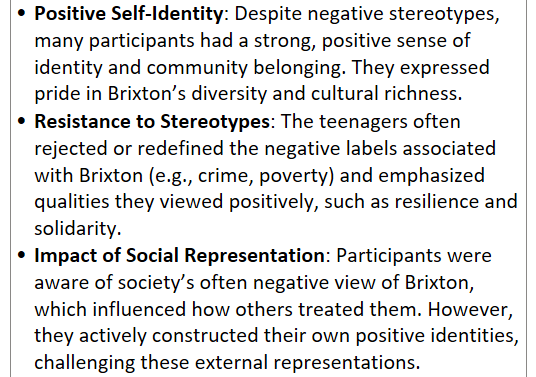Howarth - Brixton STudy
1/9
There's no tags or description
Looks like no tags are added yet.
Name | Mastery | Learn | Test | Matching | Spaced |
|---|
No study sessions yet.
10 Terms
title
year
2002
aim
To investigate how young people in Brixton perceive themselves and their community, and to understand the influence of social identity on these perceptions.

method
qualitative approach through focus group interviews

particpants
44 teenagers aged 12 to 16, who were residents of Brixton, a multicultural area in London. These participants were recruited from local schools and youth groups

procedure
Focus Group Interviews: Participants were organized into focus groups based on age and gender to discuss topics related to identity, community, and how they believe others perceive Brixton.
Guiding Questions: The discussions centered around perceptions of Brixton, stereotypes associated with the community, and personal experiences within their social environment.

Thematic Analysis: Howarth analyzed the discussions to identify themes that reflected the participants’ social identities, self-perceptions, and views on societal attitudes.
findings
Positive Self-Identity: Despite negative stereotypes, many participants had a strong, positive sense of identity and community belonging. They expressed pride in Brixton’s diversity and cultural richness.
Resistance to Stereotypes: The teenagers often rejected or redefined the negative labels associated with Brixton (e.g., crime, poverty) and emphasized qualities they viewed positively, such as resilience and solidarity.
Impact of Social Representation: Participants were aware of society’s often negative view of Brixton, which influenced how others treated them. However, they actively constructed their own positive identities, challenging these external representations.

cocnlusion
Howarth concluded that social identity is influenced not only by self-perceptions but also by how society represents one's community. The youth of Brixton demonstrated resilience by creating a positive self-identity in the face of negative social representations.

strengths
supports the theory
limitations
Social desirability bias, quliattive hence subjective interpretations
